
Stomas ning
This topic is to be presented at the Learning Technologies conference 6-7 November 2008 in Mooloolaba, Queensland, accompanied by a Slideshare “slidecast”
http://www.slideshare.net/ozi/using-online-social-networking-tools-to-connect-with-clients-presentation-668854
Abstract.
Building an online community linking trade skills students, their employers, and other educators, creates a knowledge-sharing environment that enhances traditional TAFE training. In this paper, stonemasonry teacher Simon Brown shares how he uses a range of learning technologies in a TAFE context.
Introduction.
The ancient craft of stonemasonry is continually being re-invented with the development of new materials, tools and techniques. World-wide, the stone industry demands responsive training, and with Queensland’s geographic spread this means making full use of online learning and communications technologies.
Free Web tools (Ning, Wikispaces, Flickr, Youtube) together with the Videolinq media streaming service have the ability to engage students and guide their literacy development. Catering for various learning styles, online tools provide a platform for re-focusing text-based learning resources into image-rich interactive learning experiences. The tools allow trade skills teaching staff to collaborate online with industry personnel about training requirements, and to display apprentice achievements in a global community. The skills necessary to start and operate in an online network were not found in a formal course, but were instead developed by using the tools, and by regularly discussing educational technologies with educators working in schools, TAFEs and universities.
As a SkillsTech Australia stonemasonry trade skills teacher, I’d like to share my experiences building a learning community with online social networking tools.
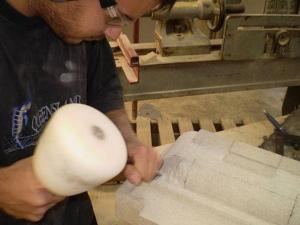
Stone industry skills
Stone industry skills.
Stonemasonry is a Rare Trade. I learned about it while I was still at school, helping a stonemason build rock walls and paving during weekends and holidays. Stone is mostly used as a durable cladding over structural elements to make them visually appealing. Working in the stone industry is heavy physical work, often outdoors and up scaffolding – well-suited to a young person with an eye for detail.
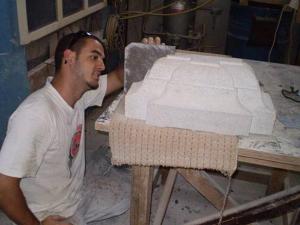
Stonemasonry training at TAFE
Later, I served an apprenticeship with a monumental and building stonemasonry firm at Toowong. Together with my wife, I operated a small sub-contracting company until an opportunity arose to teach my trade at Eagle Farm in Brisbane, and now I work for SkillsTech Australia providing pathways to a calling for Queensland apprentices and RPL candidates.

Erecting a stone monument
The stone industry in Australia is made up of small employers, in cities and regional towns. Apart from formal TAFE classes, trade skills knowledge sharing is confined within each workplace. There is no stonemasonry trade association in Queensland, and communications between members of the stone industry are very limited. Addressing this situation, I am building an interactive online learning community using the electronic tools we all have at our fingertips.

Travelling to TAFE
Training in the stone industry.
Formal training for Queensland apprentices means that they travel from many locations to Eagle Farm for four separate block-release training sessions. Visits are usually spaced between six and twelve months apart, so that they benefit from using their new skills in varied settings after they return to work. However, students lose skills when they don’t use them for any length of time. Having a community place to visit between classes strengthens the learning connections begun in formal classes.
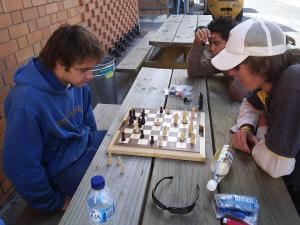
Between training sessions
Although employers can be disadvantaged in the short term by their apprentices’ absences at TAFE, time between training sessions in the TAFE training workshop spent socializing with their peers is a valuable networking opportunity as they compare work methods and working conditions. Life-long connections are made at TAFE.
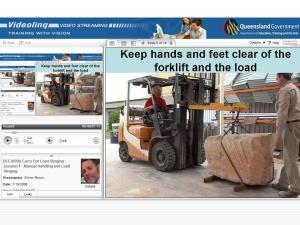
Videolinq
Blending training delivery.
Stonemasonry training is delivered mostly face-to-face in the training workshop, with a range of electronic media used to enhance learners’ experiences. My students are Queensland stonemasonry apprentices, passionate about their trade. They are visual and kinesthetic learners, and learn best by visual stimulation – in particular, moving images powerfully focus their attention –and they prefer “learning by doing”. Together with my colleagues, we created a series of media streams stored in Videolinq’s Mediasite server. Students view Videolinq audiovisual media streams wherever they have a network connection – in class, at work and at home.
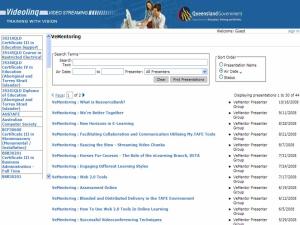
The Videolinq archive
Videolinq hosts the weekly Vocational e-Learning Mentors network videoconferences. Taking part in the VeMentoring network gives me access to a resource of training delivery tips and tricks, and helps me to develop confidence as a video conference presenter.

Teacher at the centre, distributing knowledge
Changing the training delivery focus.
Traditional classroom delivery places the teacher at the centre of the students’ learning experience, pushing information out.

Drawing-in knowledge
However, I’m changing the perspective, pulling information in to a common space…

Sharing knowledge
…creating an environment where students can share knowledge with each other.
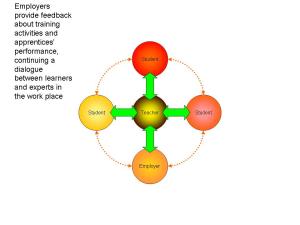
Connecting with apprentices
By engaging students to build their own online space, employers are encouraged to provide feedback about training activities and apprentices’ performance, continuing a cycle of responses between learners and experts in their work places.

Connecting employers and apprentices
Using electronic social networking applications, I’m building stronger links between stone industry apprentices and employers in a learning environment.

Connecting masters, operators and novices
The target situation is a strongly-supported learning network comprised of masters, operatives and novices. It works because I personally model desired behaviour – connecting, inspiring, and empowering learners, employers and my colleagues. I believe that every trade skill area should do this.

Connecting students
The stonemasonry Ning network.
Ning provides free social networks for interest groups – I started this one for my students in July 2007, and there are now sixty-five members. Access to Ning was initially blocked in the education network, but it has now been re-instated with limited capability. Each new group of apprentices joins the network as part of an assessment task in communications, and each student is encouraged to upload a visual journal of hand and power tool skills, in the contexts of safety, quality and sustainability.

Network tools
I use Ning’s free templates to supplement TAFE Queensland’s Learning Management System – it has many tools for a network manger to use. One of the network’s functions is embedding widgets (web objects) that import feeds from other sites.

Importing tagged photos into a widget
A good example of a feed source is Flickr photo sharing – the latest “stonemasonry” tagged Flickr photos from contributors around the world are displayed in a constantly updated widget.

Analyzing site statistics
Google Analytics helps me to gauge the usefulness of the network as a collaboration tool, counting and analysing site visits by locations and traffic sources.

Locating site visitors
Viewable as a widget on the main page, a ClustrMap displays locations of visitors to the network. The map records two thousand three hundred separate visitors in eighteen months, including four hundred since June this year. Students are aware that many people from all over the world are viewing their online activities.

Showcasing process skills
Network members have their own page to customise with photos and videos, music and style elements, showcasing their workplace achievements.

Telling the story with images
I encourage employers and tradesmen to join the site, so that it becomes an online community for the stone industry worldwide. Nearly two hundred and fifty photos and fifty videos answer the question: “What is a stonemason?”

A narrative in images
But, it’s not just about the facts – it’s a narrative. Everyone has a story to tell.
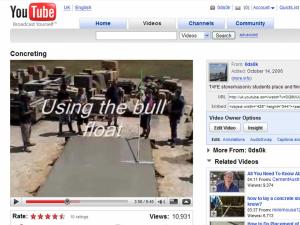
Reaching a wider audience
Youtube is a great tool for sharing knowledge – a video clip featuring my students carrying out a concreting exercise has been viewed nearly eleven thousand times in two years. I used to delete offensive comments and block troublesome users, but now I affirm negative remarks with positive statements. I find that addressing negative comments in this way encourages more positive comments to be posted.
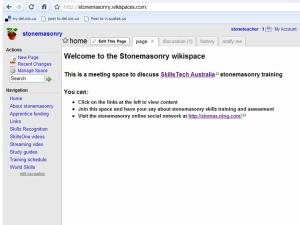
Responding to requests for information
The stonemasonry Wikispace.
In May this year, I opened a free Wikispaces account to complement the Ning network. Student feedback suggested that the Ning website was “cluttered” – Wikispaces offered a chance to work with an unencumbered template. The stonemasonry wiki is an information centre that can be easily updated, answering questions about administrative processes – whenever I speak with employers, I direct them to the wiki. Students in class are introduced to the site, and joined up as members, contributing by suggesting topics that are missing from the site. It is building to be a useful display of stone industry information.
Learning in a learning community.
Setting up and maintaining an online community would not have been possible without the support of my personal learning network. My personal learning network is made up of people in Australia and other countries who share my passion for using new technologies to connect with students, learning about social networking tools useful for educational purposes, and building the skills necessary to operate them in a learning community.
It’s not a matter of knowing how to do it – taking the first step leads to the next, and in a supportive community, friends will help you find your feet.
Conclusion.
Every teacher should be using social networking tools to connect with their clients. Get a gmail account. Join or create a Ning network and invite friends to join up. Get a Twitter account and start adding friends. Use Yammer at work to cut back on useless email traffic, and start sharing rich, real knowledge.




























